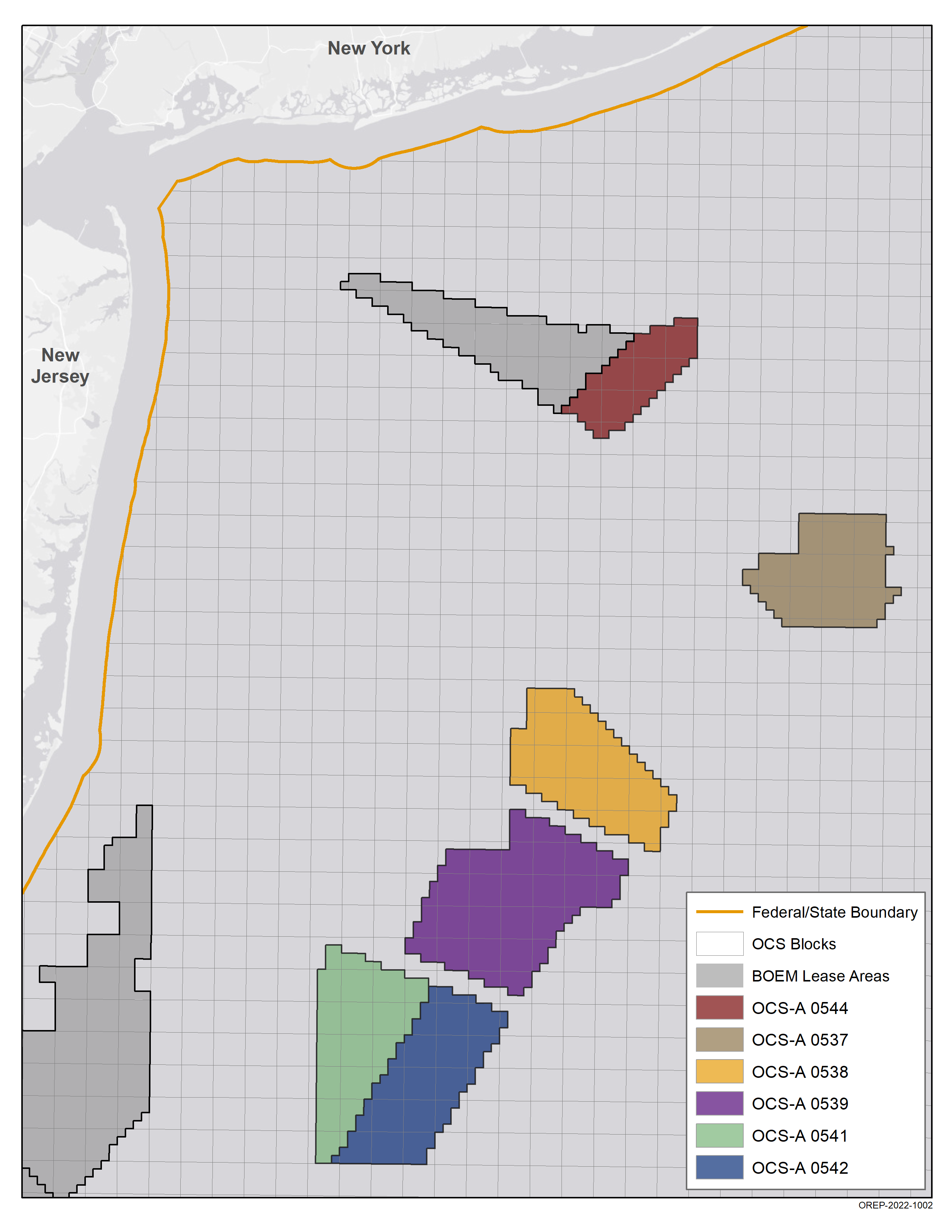The Biden administration announced plans Wednesday to auction more than 480,000 acres in the New York Bight for six new offshore wind energy leases, the administration’s first wind sale and the largest lease area ever offered, a with potential build-out capacity up to 7 gigawatts.
In a joint announcement with governors of New York and New Jersey, Interior Secretary Deb Haaland said the “administration has made tackling the climate crisis a centerpiece of our agenda, and offshore wind opportunities like the New York Bight present a once-in-a-generation opportunity to fight climate change and create good-paying, union jobs in the United States. We are at an inflection point for domestic offshore wind energy development. We must seize this moment – and we must do it together.”
New York and New Jersey state governments have set the nation’s largest regional offshore wind target, aiming for over 16 GW of offshore wind by 2035. Construction is to begin this year on the South Fork Wind project 35 miles east of Montauk, N.Y., and the Ocean Wind 1 project off southern New Jersey would be next.
The Bureau of Ocean Energy Management says a new U.S. offshore wind industry “presents a $109 billion opportunity in revenue to businesses in the supply chain over the next decade.” Industry advocates said the New York Bight auction will create one of the world’s biggest markets for the technology.
“These six new lease areas will draw in new investors and developers to the U.S. market and foster the competition that will catalyze major supply chain development regionally and nationally,” said Liz Burdock, president and CEO of the Business Network for Offshore Wind. Sustaining this momentum is critical to the federal government to support the new but quickly growing U.S. offshore wind manufacturing base and supply chain.”
“The New York Bight offshore wind lease sale is much anticipated and long awaited. It has been more than three years since the ‘bidding bonanza’ lease sale offshore Massachusetts, and now we finally have a set date for what will be an incredible energy and economic opportunity,” said Erik Milito, president of the National Ocean Industries Association. “With their large economies and massive populations, New York and New Jersey are two coastal states critical to the development of American offshore wind.”
Commercial fishing advocates stressed that BOEM needs to make a priority of avoiding and mitigating negative impacts their industry and the nation’s seafood supply. The waters between. New York and New Jersey are some of the most productive on the East Coast and account for much of the sea scallop harvest, valued at $746 million in 2019, according to the Fisheries Survival Fund.
In comments submitted to the agency, the group called on BOEM “to create an ‘adaptive and proactive mitigation plan’ that will allow both fisheries and offshore wind to prosper.”
“It is unquestionable that the proliferation of new turbine arrays will have detrimental impacts on the scallop fishery and other fisheries,” according to a statement from the Fisheries Survival Fund. “Windfarms will and demonstrably do change ocean ecosystems. The goal of mitigation should be to strike a balance that ensures mutual prosperity, not merely an uneasy, zero-sum co-existence.”
BOEM says its initial consideration of 1.73 million acres in the New York Bight was reduced by 72 percent “to avoid conflicts with ocean users and minimize environmental impacts. BOEM will continue to engage with stakeholders as the process unfolds.”
In 15 pages of detailed recommendations to BOEM, the Fisheries Survival Fund called for “a long-term, flexible approach to reducing impacts to scallops, which are extremely sensitive to changes in the ocean environment. This approach should ensure cohesive and meaningful coordination between fishing communities, developers, state agencies, and federal regulators.”
The agency must work with regional fishery management councils' technical plan development teams “that are experts in conservation and management of the specific fisheries resources under their jurisdiction,” the group said. Workshops between fishermen, wind developers and BOEM “may be useful if they are interactive and not simply listening sessions.”
The group said fishermen worry about “developers conducting mere desktop exercises to simply check a NEPA (National Environmental Policy Act) box are neither sufficient to mitigate impacts comprehensively nor to compensate fisheries fully and accurately.”
The lease terms will include new stipulations, including a rule that prevents wind companies from bidding on more than one lease, and incentives to enter labor agreements with unions and use U.S.-built components.
“We applaud and thank the administration for not only promoting necessary clean energy projects, but for also ensuring that these projects lead to good-paying, unionized jobs that will directly support the communities they impact,” said Jason Walsh, executive director of the BlueGreen Alliance, a coalition of labor and environmental groups.
While some environmental advocates praise the lease sale plans, not all are on board.
“Rather than focusing on faster, cheaper, safer, better green energy solutions, the region is racing to sell-off large scale areas of the ocean to major industrial developers, including Big Oil,” according to a statement by Clean Ocean Action, a New Jersey-based ocean environment group.
“This massive industrialization of this essential ocean realm is larger than anywhere in the US waters: there are already at least 550 wind turbines proposed in the New York-New Jersey/Bight, not including those that would result from the 488,201 acres announced today, and these turbines will be significantly larger than any other turbines in operation in the world,” the group said.
From its start as a local grassroots group in the 1980s, Clean Ocean Act evolved to a lobbying and legal action effort that in the 1990s pressured the Port Authority of NY/NJ and the Corps of Engineers in court to end ocean dumping of harbor dredge spoils.
“Clean Ocean Action supports responsible and reasonable offshore wind which can play a part in climate change solutions,” the group said. “However, the leases announced today and the fast-tracking of offshore wind energy development are neither.”





